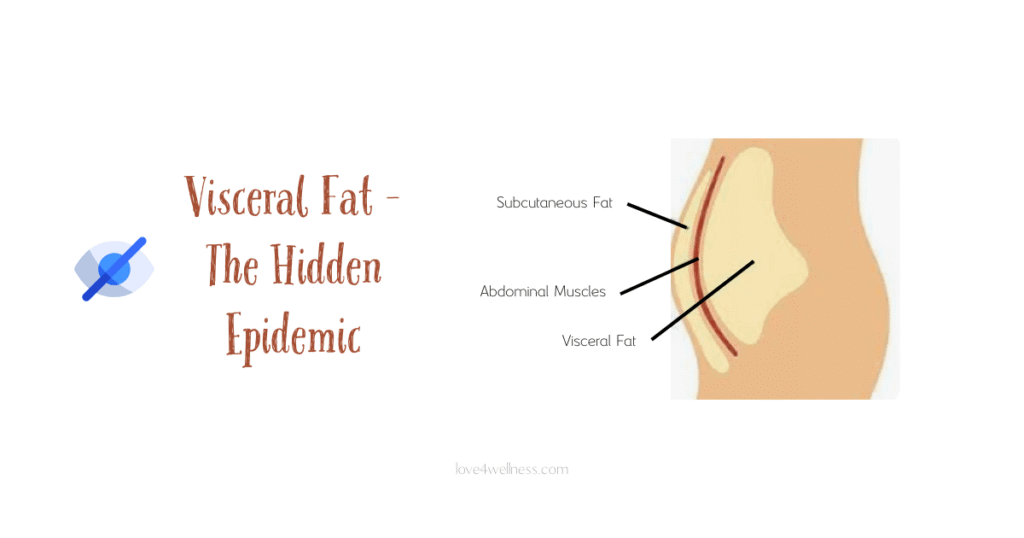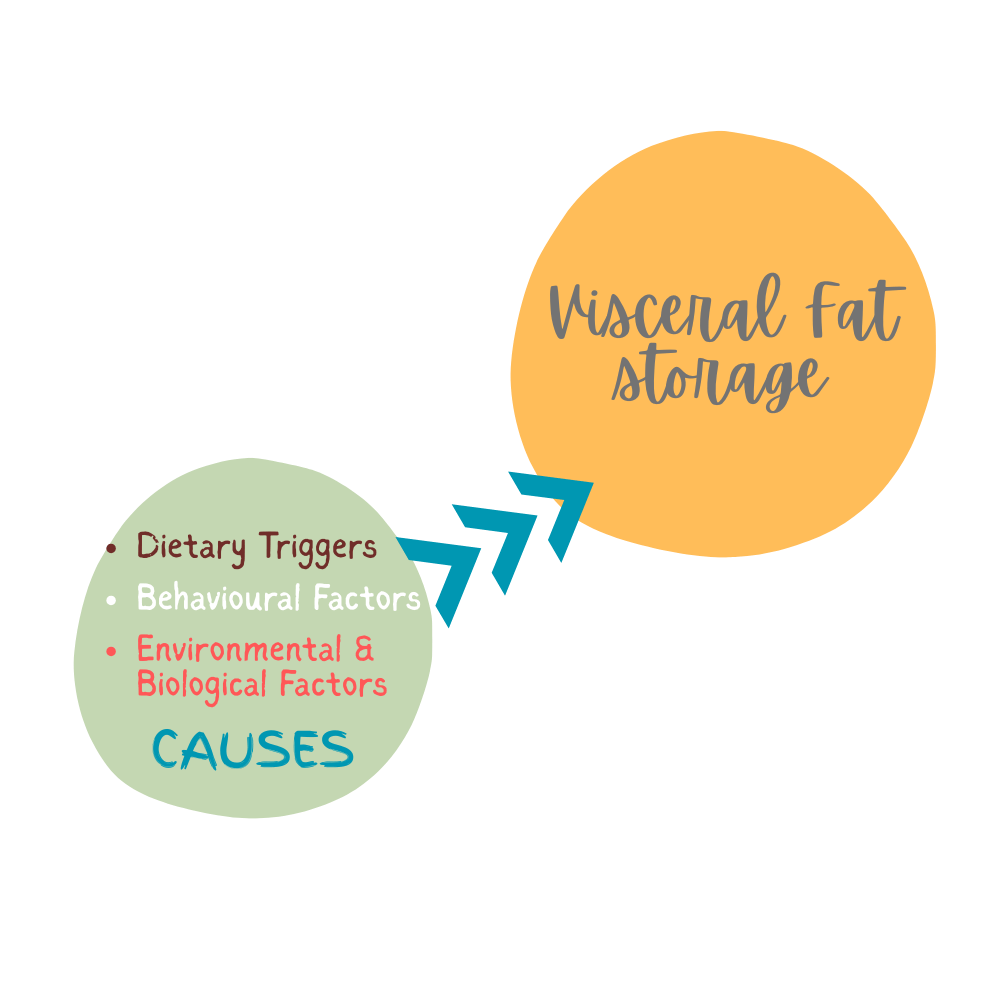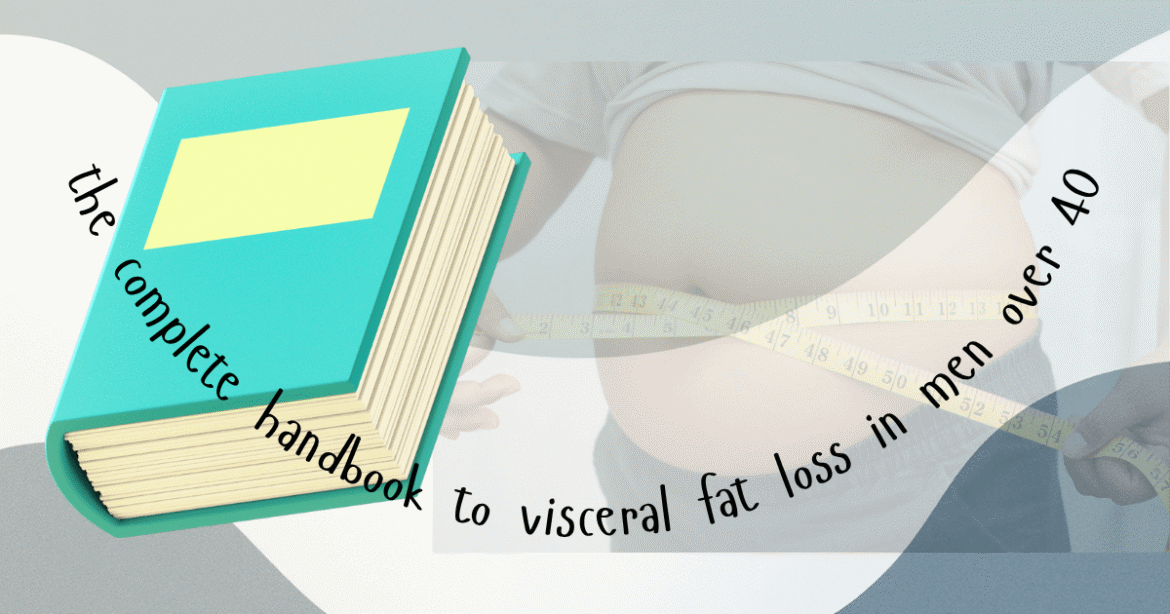For most men, the forties mark a subtle but decisive turning point. The same meals, workouts, and habits that once kept you trim begin to betray you. The waistline thickens; shirts fit differently. You tell yourself it’s “just age”. However, this isn’t just about looks or age; it’s about visceral fat, the hidden kind that wraps around your organs and disrupts hormones. This complete guide on visceral fat loss for men over 40 will help you understand why it happens, how to assess it, and how to lose it safely and permanently.
1. The Hidden Epidemic: Why Men Over 40 Need to Rethink Belly Fat

The modern midlife male faces a largely invisible epidemic — visceral fat accumulation. Unlike the fat you can pinch, visceral fat lodges itself deep within the abdominal cavity, enveloping the liver, pancreas, and intestines. You may look only mildly overweight, or even lean, yet carry dangerous amounts of this internal fat.
Visceral fat is not inert storage tissue. It is metabolically active, functioning like an organ that secretes hormones and inflammatory molecules, influencing every system in your body. Over time, it reshapes metabolism, disrupts hormones, and accelerates disease.
Most men associate belly fat with overeating or inactivity. In reality, visceral fat is a metabolic and hormonal disorder — the result of declining testosterone, elevated cortisol, impaired insulin sensitivity, and reduced muscle mass. The shift is slow but relentless, creating what scientists call metabolic inflexibility — your body loses its ability to switch efficiently between burning carbohydrates and fats.
| AT A GLANCE: –> Visceral fat increases silently after 40 due to hormonal and lifestyle changes. –> It drives inflammation, insulin resistance, and low testosterone. –> Losing it restores not only your shape but your long-term metabolic resilience. |
2. What Exactly Is Visceral Fat? The Physiology Behind the Problem
Every man carries several types of fat. Subcutaneous fat lies just under the skin, cushioning muscles and joints. Intramuscular fat provides localized energy for muscle contraction. Visceral fat, however, is different — it surrounds organs in the abdominal cavity, stored within the viscera, hence its name.
The Functional Side of Visceral Fat
In small amounts, visceral fat serves a purpose:
- It protects organs from mechanical stress.
- It acts as an emergency fuel reserve during starvation.
- It secretes adiponectin, a hormone that enhances insulin sensitivity.
The problem arises when this depot expands beyond its healthy range. Excess visceral fat transforms from protective to pathogenic. Enlarged fat cells release cytokines (IL-6, TNF-α) and free fatty acids directly into the portal vein, flooding the liver. This triggers hepatic fat buildup and systemic inflammation — the first domino in the chain of metabolic syndrome.
The Hormonal Cross-Talk
Visceral fat produces hormones that constantly talk to your brain and endocrine system:
- Leptin regulates hunger but becomes less effective when fat levels rise — a condition known as leptin resistance.
- Resistin impairs glucose metabolism.
- Adiponectin, once abundant, declines, worsening insulin resistance.
The result is a hormonal milieu that promotes further fat storage even when calorie intake is moderate.
Seeing the Invisible
You can’t always see visceral fat, but you can estimate it:
- Waist-to-height ratio (keep it below 0.5).
- Waist circumference (above 102 cm / 40 inches indicates risk).
- DEXA or MRI scans provide precise measurements, but simple tape-measure tracking and body-shape observation are practical substitutes.
In essence, visceral fat hides in plain sight — invisible yet metabolically loud.
3. Why Men Over 40 Are Especially Vulnerable

By midlife, the male hormonal landscape shifts dramatically.
The Testosterone Decline
Beginning around age 35, testosterone levels fall by roughly 1% per year. This decline reduces muscle protein synthesis, lowers metabolic rate, and shifts fat storage toward the abdomen. Lower testosterone also blunts motivation and energy, indirectly reducing physical activity, leading to a self-perpetuating cycle of accumulation of belly fat.
Cortisol and Chronic Stress
Work pressure, other responsibilities, and sleep disruption keep cortisol chronically elevated. Cortisol, in evolutionary terms, prepared the body for survival. In modern life, it simply instructs your system to store fat centrally, near the organs where it can be quickly mobilized — except that in today’s sedentary context, it never gets used.
Insulin Resistance and Mitochondrial Slowdown
As muscle mass declines, so does glucose disposal capacity. Cells respond sluggishly to insulin, prompting the pancreas to produce more. Persistently high insulin levels block fat breakdown (lipolysis) and encourage visceral storage. Meanwhile, aging mitochondria — your cellular “engines” — burn fuel less efficiently, reducing overall energy expenditure.
The Growth Hormone Connection
Sleep deprivation and aging blunt growth hormone (GH) secretion. GH normally promotes fat oxidation and lean-tissue repair. When deficient, fat accumulates and muscle recovery lags.
The Hormone Cascade Leading to Abdominal Fat Storage
Low Testosterone → Reduced Muscle → Lower Metabolic Rate → Higher Insulin → More Fat Storage → Further Hormonal Suppression.
Breaking this cycle requires deliberate intervention — strength training, restorative sleep, and nutrient-dense eating — not just “eating less.”
4. Root Causes: Lifestyle, Diet, and Environmental Triggers

Visceral fat doesn’t develop overnight. It is the cumulative expression of modern living — high stress, disrupted sleep, nutrient-poor convenience foods, and minimal movement.
Dietary Triggers
- Refined carbohydrates and sugars flood the bloodstream with glucose, causing insulin spikes that leads to visceral fat storage.
- Fructose, abundant in soft drinks and desserts, is processed in the liver and directly converted to triglycerides — fueling fatty-liver disease.
- Alcohol, especially beer and sweet cocktails, adds empty calories and impairs fat oxidation. Two to three drinks daily can raise visceral fat even when total calorie intake is moderate.
- Low-protein diets reduce thermogenesis and satiety, leading to overeating and muscle loss.
Behavioural Factors
- Sedentarism: Sitting 8–10 hours daily downregulates lipoprotein lipase, an enzyme critical for fat breakdown.
- Sleep deprivation: Fewer than 6 hours per night raises ghrelin (hunger hormone) and cortisol while lowering leptin (satiety hormone).
- Stress eating and time pressure encourage the consumption of ultra-processed convenience foods high in trans fats and additives.
Environmental and Biological Factors
- Endocrine disruptors such as BPA, phthalates, and certain pesticides mimic estrogen, worsening male hormonal imbalance.
- Gut dysbiosis (imbalanced microbiota) increases intestinal permeability and systemic inflammation — now recognized as a contributor to visceral obesity.
- Age-related sarcopenia: Without resistance exercise, men lose 3–5% of their muscle mass per decade, reducing energy expenditure and insulin sensitivity.
Practical takeaway:
No single factor creates visceral fat — it’s the interplay of diet, hormones, and daily behaviour. Addressing one lever (for example, exercise) while ignoring others yields limited results.
5. The Health Toll: How Visceral Fat Erodes Systemic Health
Visceral fat is not just a passive burden; it’s a biochemical agitator influencing nearly every organ.
Metabolic Disorders
Excess visceral fat drives insulin resistance, the root of metabolic syndrome — a cluster of conditions that includes high blood sugar, hypertension, and dyslipidemia. Free fatty acids released from visceral fat flood the liver, raising VLDL, triglycerides, and lowering HDL cholesterol.
Cardiovascular Damage
Inflammatory molecules from visceral adipose tissue impair endothelial function, making arteries less flexible. Plaques form more easily, and clotting factors increase, heightening the risk of heart attack and stroke. Even men with “normal” weight but high waist measurements show significantly elevated cardiovascular risk.
Liver Dysfunction
Fat infiltration in the liver — non-alcoholic fatty liver disease (NAFLD) — compromises detoxification, hormone metabolism, and cholesterol regulation. The liver becomes sluggish, perpetuating metabolic dysfunction.
Hormonal Disruption
Visceral fat expresses the enzyme aromatase, which converts testosterone into estrogen. The result: lower androgen levels, reduced libido, fatigue, and further fat deposition. This feedback loop accelerates the aging process.
Inflammation and Accelerated Aging
Chronic low-grade inflammation (“inflamm-aging”) damages DNA, proteins, and mitochondria. It’s now considered a key driver of early cognitive decline and immune dysfunction in midlife men.
Mental and Cognitive Health
Inflammatory cytokines can cross the blood-brain barrier, altering neurotransmitters such as serotonin and dopamine. This partly explains the correlation between central obesity and depression, anxiety, and diminished focus.
Summary Table: The Domino Effect of Visceral Fat on Male Health
| Endocrine | Low Testosterone, High Cortisol | Fat gain, muscle loss |
| Metabolic | Insulin Resistance | Type 2 Diabetes |
| Cardiovascular | Endothelial Dysfunction | Heart Disease, Stroke |
| Hepatic | Fatty Liver (NAFLD) | Metabolic Syndrome |
| Nervous | Neuroinflammation | Depression, Brain Fog |
6. The Science of Losing Visceral Fat

Here’s the encouraging truth: visceral fat is biologically easier to lose than subcutaneous fat once metabolic balance is restored. Hence, with awareness, visceral fat loss in men over 40 is doable.
Hormonal Reset Comes Before Calorie Deficit
Many experts agree that losing visceral fat after 40 depends more on balancing hormones than cutting calories. Energy balance matters, but hormonal signaling dictates where fat is lost. Reducing refined carbs, managing stress, and prioritizing protein lowers insulin and cortisol — two hormones that lock fat in place. Once these normalize, the same calorie deficit produces greater fat oxidation.
The Power of Muscle
Muscle tissue acts as a glucose sink. Each contraction during resistance training improves insulin sensitivity, making it easier to draw energy from fat stores between meals. Lifting weights two to three times weekly increases resting metabolic rate and elevates fat-burning enzymes.
Improving Insulin Sensitivity
- Time-restricted eating (e.g., 14–16-hour overnight fasts) allows insulin levels to drop, enabling fat breakdown.
- High-fiber diets slow glucose absorption.
- Omega-3 fatty acids and magnesium enhance insulin receptor efficiency.
Reducing Cortisol
Quality sleep, mindfulness, and low-intensity aerobic activity help lower chronic cortisol levels. Unlike stress spikes, steady cortisol elevation specifically encourages visceral storage; normalization reverses it resulting in visceral fat loss in men over 40.
Mitochondrial Renewal
Exercise, cold exposure, and certain nutrients (coenzyme Q10, alpha-lipoic acid, polyphenols) stimulate mitochondrial biogenesis — the creation of new, efficient cellular engines. More mitochondria mean more fat burned even at rest.
Why the Scale Can Mislead
As visceral fat decreases and muscle increases, body weight may remain stable or even rise slightly. True progress shows in waist reduction, improved energy, and better metabolic markers.
At a Glance: Key Biological Levers to Target
- Optimize insulin and cortisol.
- Preserve and build lean muscle.
- Support mitochondrial health.
- Prioritize restorative sleep.
- Manage inflammation through diet and lifestyle.
7. Assessing Your Visceral Fat: Knowing Where You Stand
Visceral fat is stealthy — you can’t pinch it, and often, you can’t even see it. Many men in their 40s look “average” in size yet carry significant amounts of deep abdominal fat around their organs. This section gives you the tools to estimate your visceral fat level and know where you truly stand.
i) Waist Circumference: Your First Diagnostic Tool
Forget the mirror. The tape measure is your best at-home diagnostic device.
Measure your waist at the level of your navel, standing relaxed but not slouched. For men, a waistline over 90 cm (35 inches) suggests rising visceral fat accumulation; over 100 cm (39 inches), it’s considered high risk.
Why it matters: waist size directly correlates with insulin resistance, high triglycerides, and lower testosterone—even if your weight seems “normal.”
ii) Waist-to-Height Ratio: The Simplest and Most Reliable Predictor
Divide your waist measurement by your height (both in the same units).
A ratio above 0.5 indicates excessive central fat and increased disease risk.
Example: if you’re 175 cm tall, your waist should ideally stay below 87.5 cm.
Unlike BMI, this ratio adjusts for body frame and works well for men with average or muscular builds.
iii) Waist-to-Hip Ratio
Measure around the widest part of your hips, then divide the waist circumference by the hip circumference.
A ratio above 0.9 signals visceral fat dominance — meaning your fat is stored more around your abdomen than your hips and thighs.
iv) Beyond BMI: The Limitations of the Scale
BMI (Body Mass Index) is useful for population studies, but not for midlife men. You can be “overweight” but metabolically healthy if your waist size is low, or “normal weight” yet metabolically unhealthy — the so-called TOFI (Thin Outside, Fat Inside) phenomenon.
For men over 40, body composition—the ratio of muscle to fat—matters far more than total body weight.
v) Smart Scales and Bioelectrical Impedance Devices
Consumer-grade smart scales can estimate visceral fat, but treat them as trend trackers, not diagnostics. Hydration, time of day, and meal timing can affect readings.
Instead of fixating on the number, use the scale to watch for downward trends over the course of weeks.
vi) Imaging Methods (Clinical Assessment)
- CT or MRI scans: Gold standards for visceral fat quantification, showing fat layers between organs.
- DEXA (Dual-Energy X-ray Absorptiometry) scans: Widely available, moderately priced, and give reliable estimates of regional fat and lean mass.
You don’t need a scan unless there’s a medical concern, but if you’re over 40 with metabolic risk factors, a baseline DEXA can be eye-opening.
vii) Biochemical Clues
Certain blood markers reflect underlying visceral fat:
- Fasting glucose >100 mg/dL
- Triglyceride-to-HDL ratio >3
- Elevated ALT or AST (fatty liver indicators)
- High blood pressure
If three or more are elevated, visceral fat is almost certainly part of the equation.
Self-Check Summary
If you meet two or more of these indicators — waist >90 cm, WHR >0.9, fasting glucose >100, or triglycerides >150 — visceral fat accumulation is highly likely. That’s your cue to take action and work towards visceral fat loss.
8. The 5-Pillar Framework for Visceral Fat Loss in Men Over 40
This is where understanding turns into execution. Every effective visceral fat loss strategy revolves around five controllable levers. These are not short-term “fixes,” but physiological resets that restore metabolic function.
Pillar 1: Nutrition Reprogramming
Forget crash diets. Visceral fat loss in men over 40 requires stabilizing your insulin, cortisol, and leptin cycles through consistent eating patterns and nutrient balance.
Core Principles:
- Prioritize protein: 1.6–2.0 g per kg of body weight daily helps preserve muscle and curb appetite.
- Choose complex carbs: oats, lentils, quinoa, sweet potatoes — to prevent glucose spikes.
- Include healthy fats: olive oil, avocados, nuts; they blunt insulin and improve satiety.
- Time your eating window: a 10–12-hour eating window supports circadian alignment and fat oxidation.
- Minimize alcohol and fructose: both directly raise visceral fat by impairing fat oxidation in the liver.
Avoid: ultra-processed foods, frequent snacking, and late-night eating — all of which keep insulin perpetually high.
Pillar 2: Resistance Training — The Hormonal Equalizer
Muscle is a metabolically active tissue. Every kilogram of new muscle burns energy at rest and releases myokines—anti-inflammatory molecules that directly counteract visceral fat’s cytokines.
What to Do:
- Train 3–4 times per week, emphasizing compound lifts (squats, deadlifts, rows, presses).
- Aim for progressive overload — gradually increase resistance over time.
- Include bodyweight or resistance-band workouts if training at home.
- Rest adequately: muscle growth happens during recovery, not in the gym.
Over time, strength training raises testosterone, growth hormone, and insulin sensitivity—the exact hormonal triad that keeps visceral fat at bay.
Pillar 3: Metabolic Conditioning (Cardio with Purpose)
Cardio remains vital, but how you do it matters. The goal is to improve mitochondrial efficiency and fat oxidation capacity, both helping in visceral fat loss in men over 40.
The Winning Mix:
- Zone 2 training (45–60 min) at a conversational pace, 2–3 times weekly — teaches your body to use fat for fuel.
- HIIT (High-Intensity Intervals): short 15–20 minute sessions twice weekly to boost VO₂ max and insulin sensitivity.
- Active lifestyle: Walk 7,000–10,000 steps daily; movement throughout the day prevents post-meal glucose spikes.
Pillar 4: Sleep and Recovery — The Hidden Accelerator
Midlife men often ignore sleep, yet sleep is when growth hormone peaks, testosterone recovers, and fat oxidation increases.
Your Targets:
- Aim for 7–8 hours of uninterrupted sleep.
- Maintain a consistent bedtime and dark, cool sleep environment.
- Avoid screens and alcohol 2 hours before bed.
- Consider magnesium glycinate or herbal teas (such as ashwagandha or chamomile) for relaxation.
Just one week of sleep deprivation can increase insulin resistance by up to 30%.
| What Is Sleep Deprivation? Sleep deprivation simply means not getting enough sleep for your body and mind to recover and function well. Most adults need about 7 to 9 hours of sleep each night, but many of us fall short of that. If you regularly sleep less than 7 hours, your body starts to show signs of partial sleep deprivation — tiredness, irritability, poor focus, and sugar cravings are often the first clues. Going without sleep for 24 hours or more, or sleeping less than 5 hours a night for several days, is considered severe sleep deprivation. At this stage, your brain, hormones, and metabolism all take a hit — affecting your mood, appetite, and even your ability to think clearly. |
Pillar 5: Stress and Hormone Balance
Chronic stress elevates cortisol, which redirects fat storage to the abdomen and blunts testosterone production.
How to Recalibrate:
- Integrate mindful decompression daily — meditation, deep breathing, journaling, or prayer.
- Get morning sunlight to reset circadian rhythm and improve mood.
- Build social connection — men who maintain friendships and purpose manage cortisol better.
When stress balance is restored, the hormonal environment becomes naturally fat-burning.
9. Supplements That Support the Process (But Don’t Replace It)
Supplements can enhance, but never substitute, foundational habits.
Evidence-Based Supporters for Visceral Fat Loss in Men Over 40:
- Omega-3 Fatty Acids (EPA/DHA): anti-inflammatory, improve fat metabolism.
- Vitamin D3: supports testosterone and insulin sensitivity.
- Magnesium (glycinate or malate): promotes recovery, reduces stress.
- Berberine or Alpha-Lipoic Acid: lower blood sugar, mimics mild metformin effects.
- Green Tea Extract (EGCG): supports fat oxidation.
- Creatine Monohydrate: improves strength, preserves lean mass.
Avoid miracle pills. Always consult a physician before combining supplements, especially if on medication.
10. The Mindset and Behavioral Framework
Sustainable fat loss isn’t about perfection — it’s about systems. You don’t rise to your goals; you fall to your habits.
Shift 1: From Motivation to Identity
Stop trying to “get fit.” Start being the man who trains, eats, and sleeps like a metabolically strong man. Behavior follows identity.
Shift 2: From Short-Term Goals to Long-Term Systems
Track waist size, sleep quality, and workouts weekly. The mirror lags behind biology — consistency compounds.
Shift 3: From Self-Blame to Self-Mastery
Progress stalls are not failure — they’re data. Review, adjust, and continue. Visceral fat loss in men over 40 is not linear; it’s adaptive.
11. The 30-Day Reset Plan
A practical, structured month to kickstart metabolic restoration.
Reset (Week 1):
- Eliminate alcohol, added sugar, and ultra-processed foods.
- Walk daily; sleep 8 hours.
- Track waist and morning energy.
Strength Foundation (Week 2):
- Begin resistance training 3x weekly.
- Add protein to each meal.
- Reduce late-night screen time.
Metabolic Recalibration (Week 3):
- Add HIIT twice weekly.
- Practice mindful breathing 10 min/day.
- Limit eating to 10–12-hour window.
Integration (Week 4):
- Combine cardio + strength.
- Review waist and energy metrics.
- Reflect: what habits feel natural now? Continue them.
12. From Action Plan to Lifestyle
Once visceral fat drops and waistlines shrink, the next phase begins: maintaining balance.
This isn’t about restriction — it’s about metabolic flexibility.
Maintenance Metrics
- Waist-to-height ratio: keep under 0.5
- Resting heart rate: 60–70 bpm range
- Fasting glucose: <95 mg/dL
- Muscle mass: maintain or increase yearly
Bounce-Back Strategy
If you regain a few centimeters or miss workouts, reset for one week — return to clean nutrition, proper sleep, and hydration. Momentum matters more than perfection.
Aging with Metabolic Grace
The ultimate goal isn’t a flat stomach — it’s a resilient metabolism.
When visceral fat is under control, inflammation drops, testosterone rises, and energy returns. You think sharper, move better, and age slower.
Conclusion: Reclaiming Your Metabolic Legacy
By the time most men reach their 40s, they’re told that slowing down, losing muscle, and gaining belly fat is “just aging.” That’s not true. It’s not aging — it’s adaptation to a modern lifestyle your body wasn’t built for.
Once you understand how visceral fat loss for men over 40 truly works, it stops being a mystery. You can rebuild strength, balance hormones, and reverse years of belly fat naturally—without extreme diets or endless cardio.
You’ve now learned how to reverse it — scientifically, sustainably, and permanently.
Every rep, every disciplined night of sleep, every nutrient-dense meal you eat is a signal to your body:
“I’m not fading. I’m rebuilding.”
You’re not fighting fat — you’re reclaiming your vitality, your masculinity, and your metabolic legacy.
And that, ultimately, is the real victory.
